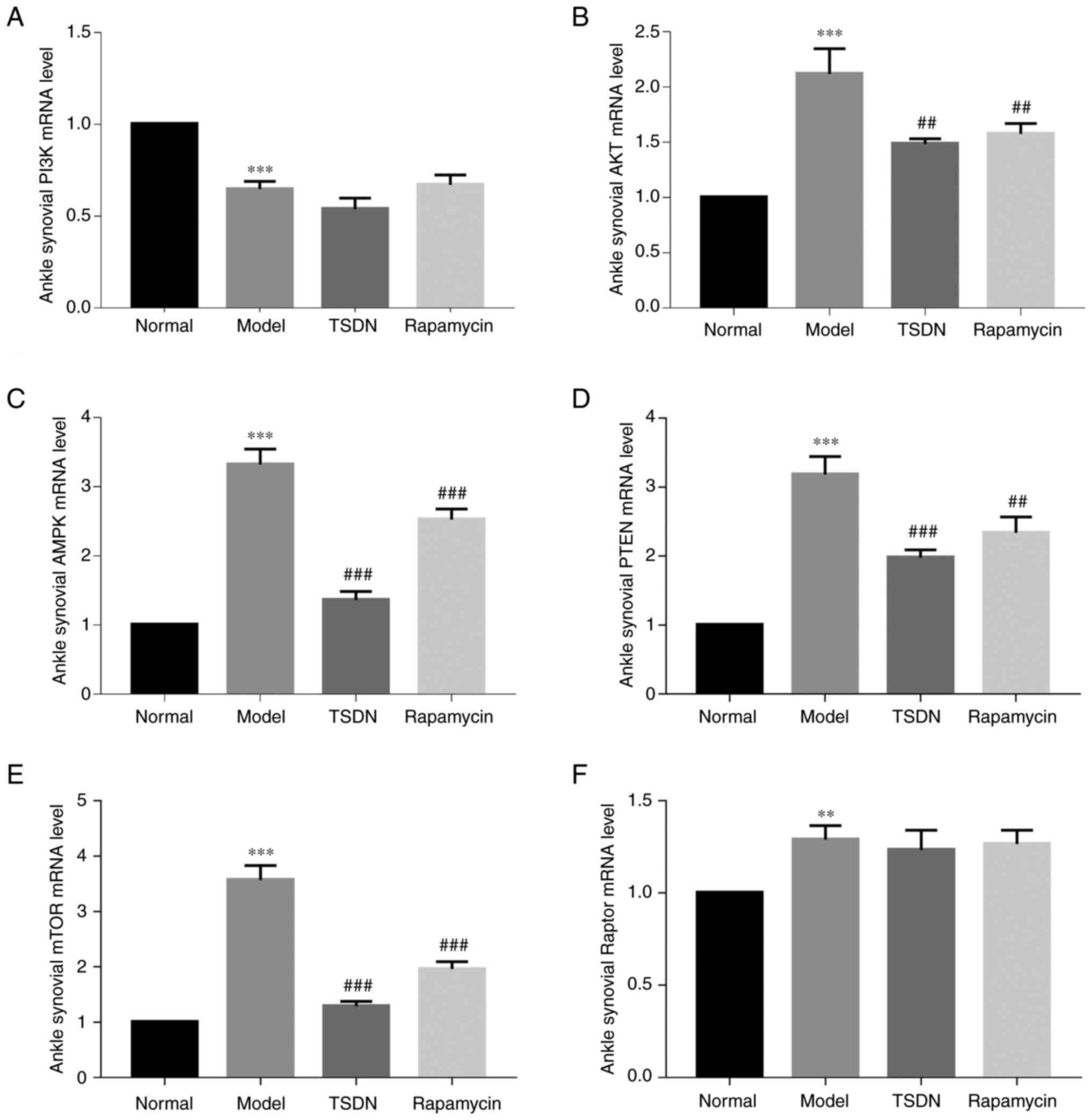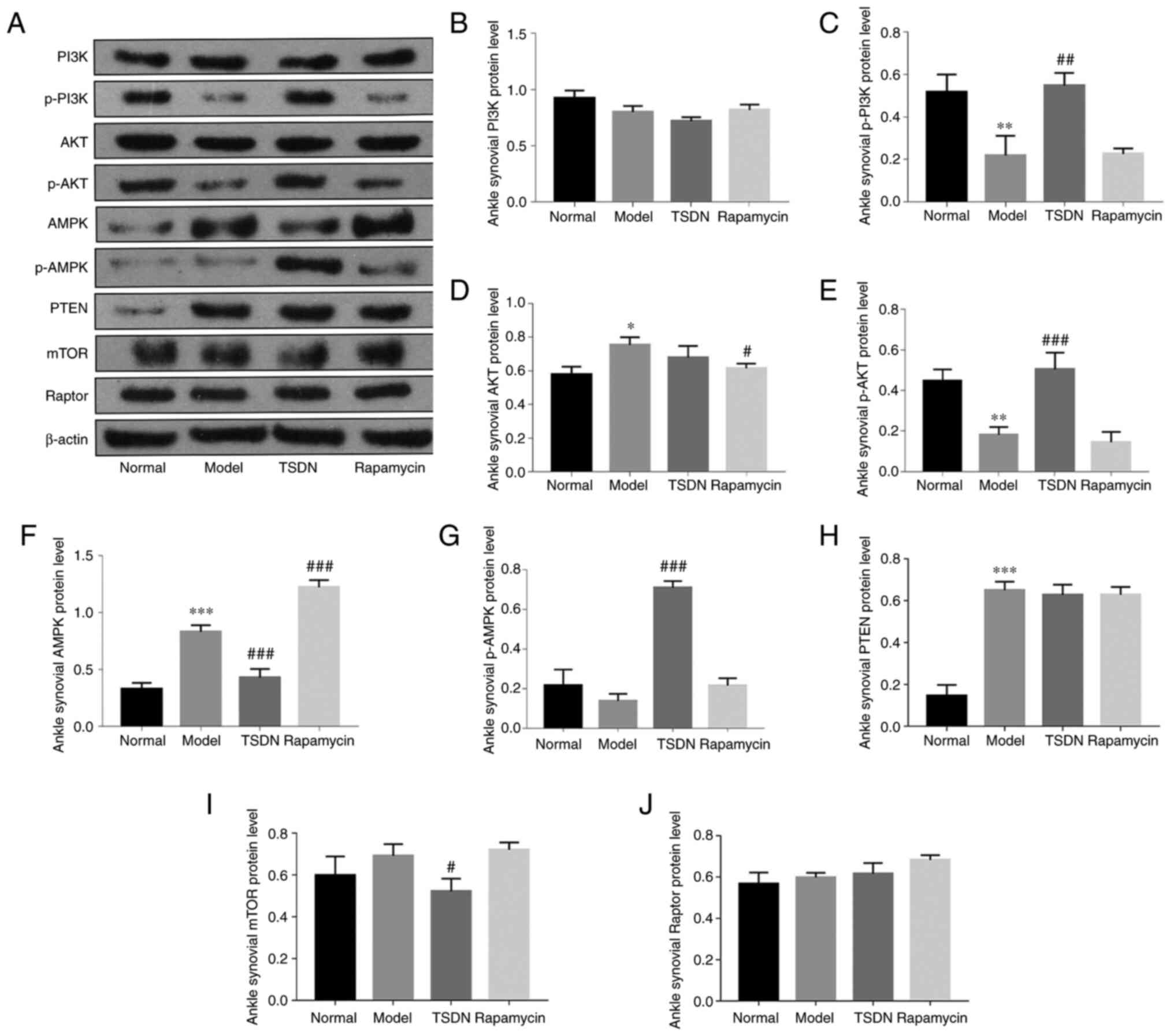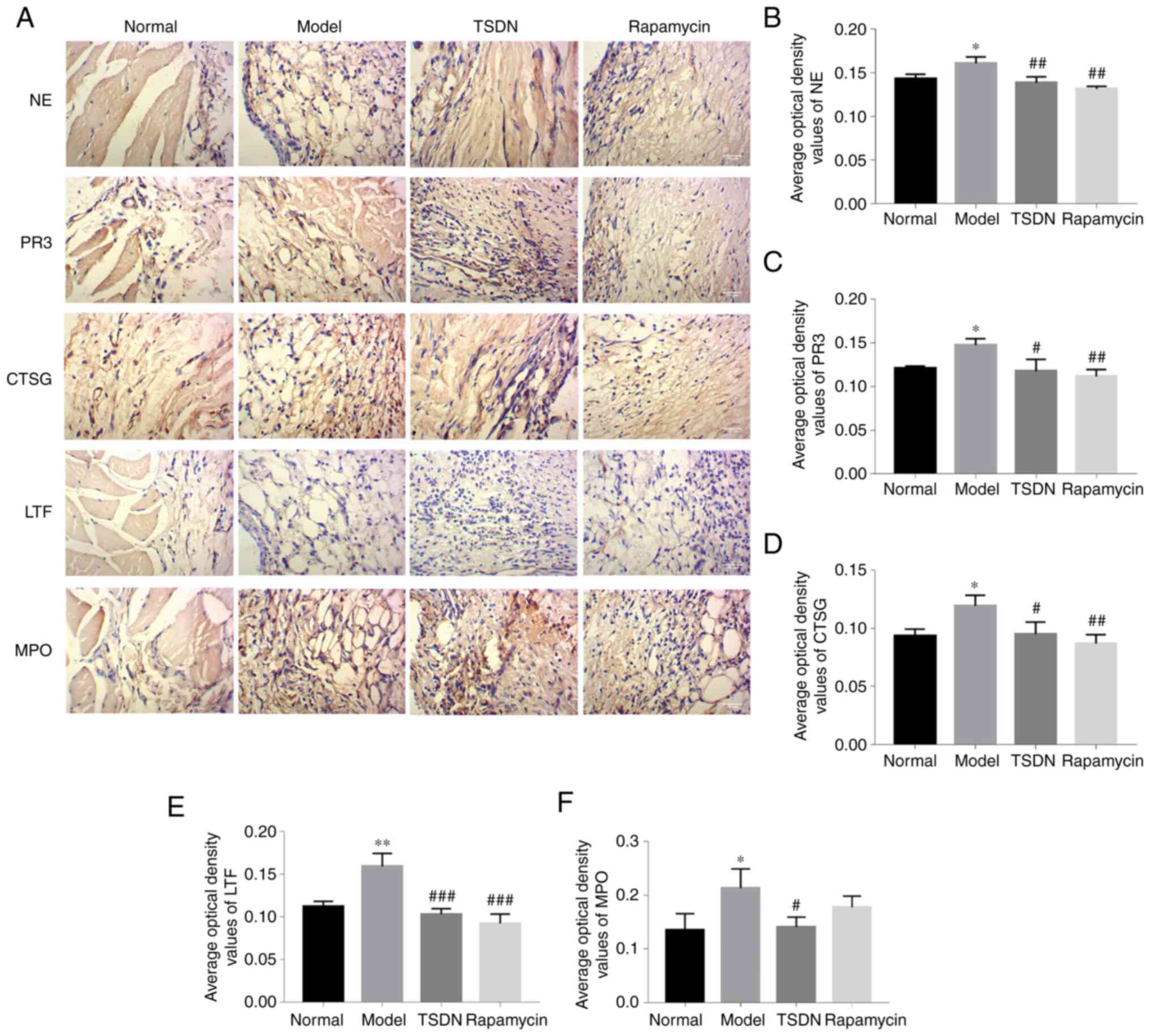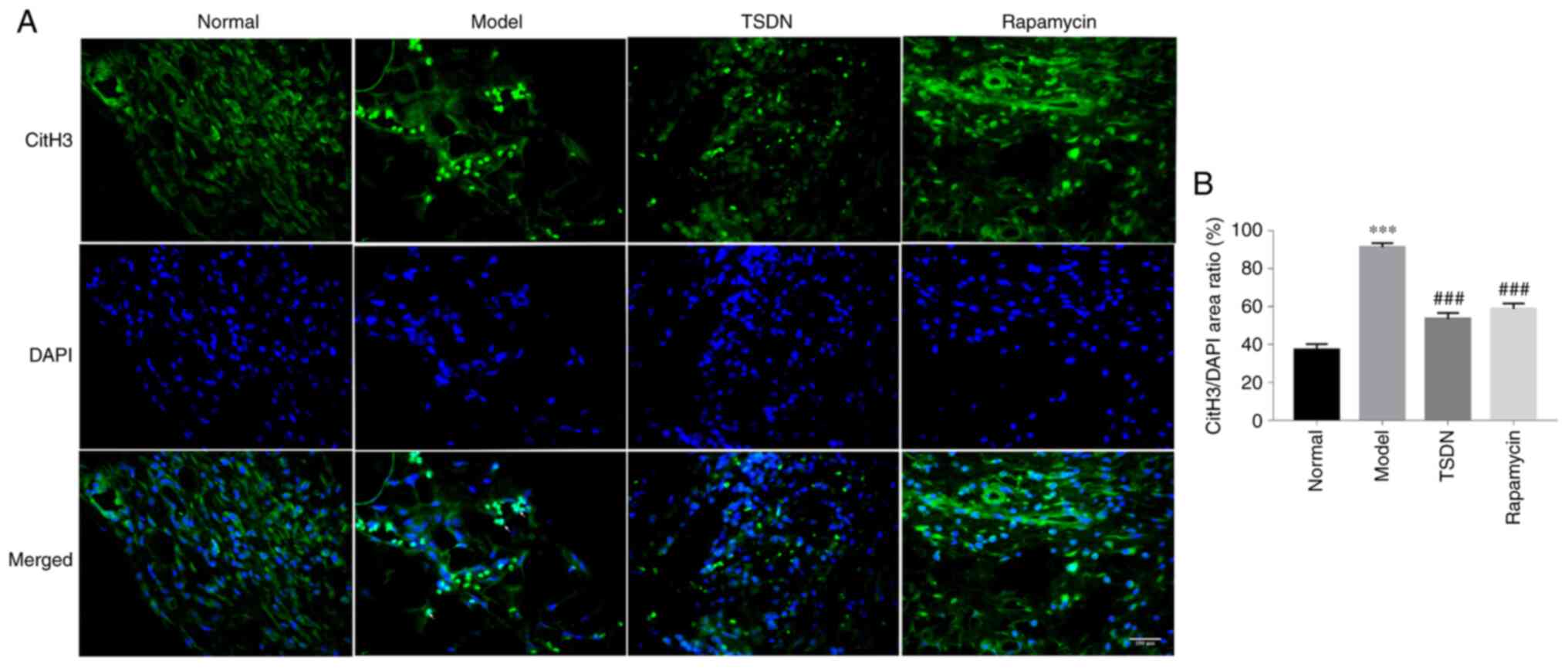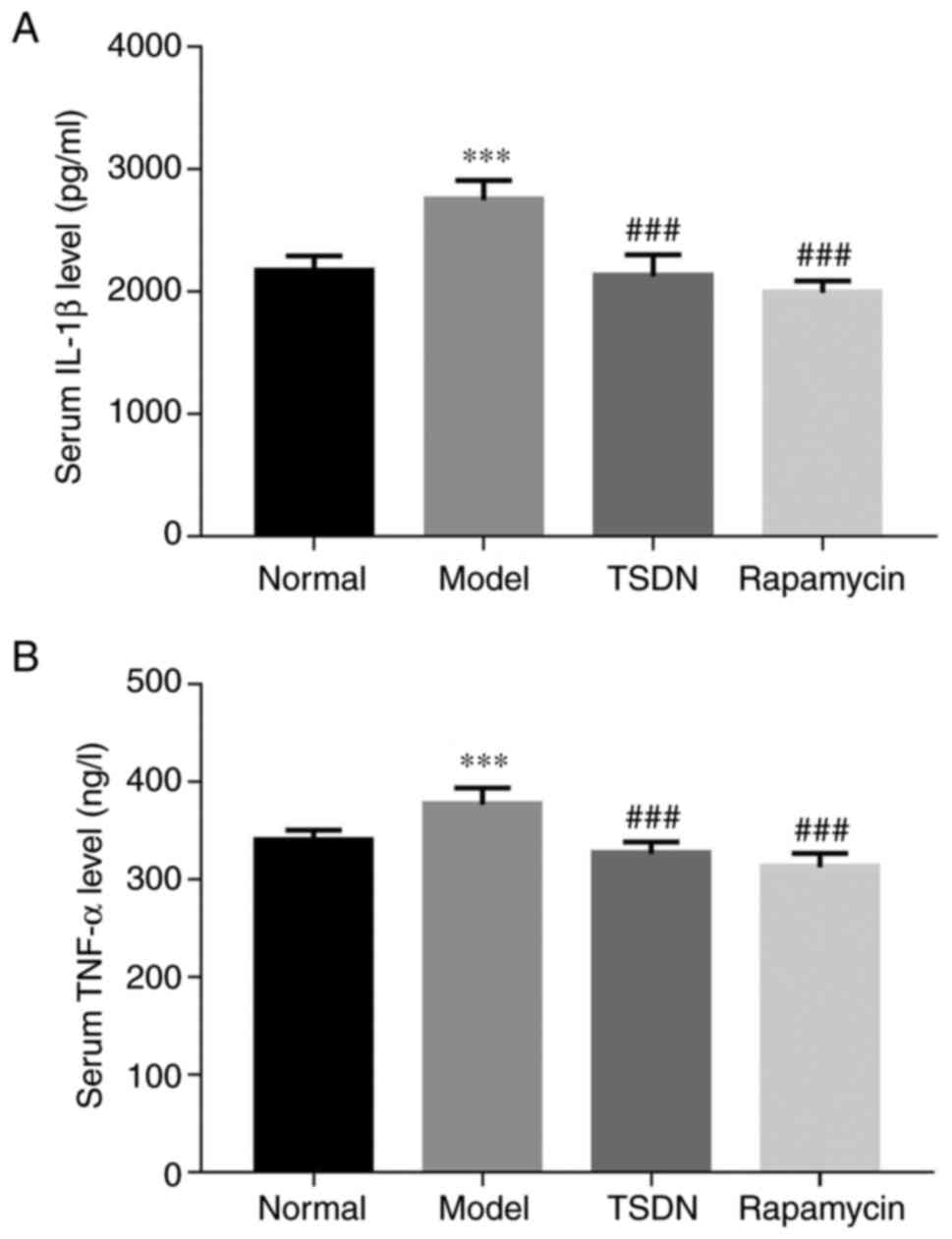Relief of gouty arthritis in rats by total saponins from Dioscorea nipponica Makino through suppression of neutrophil extracellular trap formation via the PI3K/AKT/mTOR axis
- Authors:
- Published online on: August 2, 2023 https://doi.org/10.3892/etm.2023.12146
- Article Number: 447
-
Copyright: © Zhou et al. This is an open access article distributed under the terms of Creative Commons Attribution License.
Abstract
Introduction
Gouty arthritis (GA) is a common condition that is induced by the precipitation and deposition of uric acid in articular structures (1). The most critical risk factor for the development of GA is a high serum level of urate (2). The disorder involves severe pain, swelling, warmth and redness at the gouty joint (3). To prevent GA flares, urate deposits must be eliminated by maintaining a low serum level below the saturation point of 6.0 mg/dl or less (4).
Numerous studies have concentrated on the development of novel medications to treat GA. Currently, the major medications used in the clinical therapy of gout are non-steroidal anti-inflammatory drugs, uricosuria agents and xanthine oxidase inhibitors. However, none of the commercial drugs available can both decrease serum urate levels and treat inflammation (5). Furthermore, there is compelling evidence for associations between GA and an increased risk of serious complications, including gouty nephropathy, hypertension, cardiovascular disease and diabetes (6). Thus, new, safe, and effective medicines for GA are needed.
The mTOR signaling pathway modulates the NALP3 inflammasome, which influences the production of interleukin (IL)-1β and leads to GA attacks (7,8). mTOR is an evolutionarily conservative serine-threonine protein kinase that can recognize and integrate a series of intracellular and environmental signals, including growth factors and insulin, to regulate cellular and organic reactions. The mTOR signaling pathway is highly conservative in eukaryotes and is related to the proliferation of lymphocytes, the activation of immune cells, autophagy and the metabolism of lipids and glucose, among other functions. Due to its central role in signaling pathways, recent studies have shown that mTOR correlates with GA, and it is the common pathogenic signal pathway in numerous diseases, such as vascular diseases, inflammation, obesity, progressive nephropathy and diabetes (9-13).
During the early stage of GA, monosodium urate (MSU) stimulates macrophages and produces numerous pro-inflammatory factors, such as IL-1β, which are activated by the NALP3 inflammasome. When high concentrations of IL-1β are released, the inflammatory reaction is amplified. At the same time, MSU stimulates neutrophils (NG) and accumulates them at sites of joint inflammation. MSU activates NG by the release of inflammatory factors and the formation of neutrophil extracellular traps (NETs). NETs are extracellular reticular fiber structures composed of proteinase 3 (PR3), neutrophil elastase (NE), MMP9 (matrix metalloproteinase 9), cathepsin G (CTSG), lactoferrin (LTF), myeloperoxidase (MPO), peptidoglycan recognition protein (PRPG) and high-mobility group protein B1 (HMGB1), among others (14-16). When NETs are formed, the release of serine protein kinase may activate pro-IL-1β and the NALP3 inflammasome, promote the production of inflammatory mediators, and amplify the inflammatory response.
Dioscorea nipponica Makino (TSDN) is used as a natural medicine in China and is effective in treating GA. The dried bark from its rhizome is considered to have effects of relaxing the sinews, speeding up the ‘collaterals’, stimulating blood flow, relieving pain, dispersing ‘wind’, and removing moisture. The primary active components are total saponins from TSDN, which include dioscin, protodioscin, and pseudo-protodioscin. TSDN contains both anti-inflammatory and uric acid-lowering properties.
TSDN also decreases the activities of xanthine oxidase and adenosine deaminase, thus decreasing uric acid production. It also reduces the expression levels of urate anion transporter 1 and glucose transporter 9 while increasing the expression of organic anion transporter (OAT)1 and OAT3, which promotes uric acid excretion (17). TSDN showed potent anti-inflammatory activity in previous studies and affected both the toll-like receptor (TLR)2/4-IL-1R and the NALP3 inflammasome, thus regulating the production and release of IL-1β (18,19). Since the mTOR signaling pathway is upstream of TLR2/4-IL-1R, it was aimed to determine whether TSDN has an effect on this pathway and the formation of NETs in GA rats.
Materials and methods
Preparation of TSDN
TSDN was supplied by the Tongrentang Drug Company. The plant material (voucher specimen: hlj-202028) was verified by Professor Zhenyue Wang of Heilongjiang University of Chinese Medicine. Using D-101 macroporous adsorption resin, 1 g of crude drug was separated three times for 1.5 h with 6 ml of 50% ethanol as previously described (18). A 4.97% (w/w) extraction ratio was recorded. Chemical standardization of the herbal extract was accomplished using liquid chromatography-tandem mass spectrometry (LC-MS) (Agilent Technologies, Inc.; 6470B). The three main compounds found in the herb were dioscin, protodioscin and pseudo-protodioscin (18). According to ultraviolet spectrophotometry, the extraction rate of TSDN in the extract was ~55.9%.
Animals
A total of 40 male SPF Wistar rats (8 weeks old; 250±15 g) were provided by Changsheng Biotechnology Co., Ltd. and maintained at the Heilongjiang University of Traditional Chinese Medicine. Before the experiments, the rats were housed under specific pathogen-free conditions at 22±24˚C and a relative humidity of 55±5% on a 12-h/12-h light/dark cycle with water and regular food ad libitum for 7 days and allowed to adjust to their surroundings. Animal studies were approved (approval no. 2021052801) by The Animal Ethics Committee of Heilongjiang University of Traditional Chinese Medicine (Harbin, China).
Preparation of the GA rat model
To induce the GA model, the ankle joints of rats were injected bilaterally with a suspension of MSU (cat. no. U2625; Sigma-Aldrich; Merck KGaA) on the third day of treatment (18). After modeling, the behavior of rats was monitored each day until the experiment was completed.
Animal grouping and drug administration
The rats were separated into 4 groups: i) normal, ii) model, iii) TSDN (160 mg/kg) and iv) rapamycin groups (2.5 mg/kg; rapamycin purity >99%; Nanjiang Dulai Biotechnology Co., Ltd.) (18,20). TSDN and rapamycin treatments were given every 24 h for one week. An equivalent dose of sterile saline was administered to the normal and model groups. On the seventh day, the rats were anesthetized with 3% sodium pentobarbital (45 mg/kg) by intraperitoneal injection. All rats were sacrificed by cervical dislocation after collecting 4 ml of blood from the abdominal artery in the dissection room of Heilongjiang University of Traditional Chinese Medicine, and then synovial tissue samples were collected. The blood was allowed to coagulate for 1 h at 37˚C before being centrifuged at 3,500 g for 15 min at 4˚C. It was then kept at -20˚C until testing. The tissues were stored at -80˚C. At the end of the trials, the rats were sacrificed by cervical dislocation.
Reverse-transcription-quantitative PCR (RT-qPCR)
Total RNA was extracted using TRIzol (Invitrogen; Thermo Fisher Scientific, Inc.). RNAiso Plus (cat. no. 9109), a reverse transcription kit (cat. no. RR047Q), and a SYBR Green kit (cat. no. RR420Q) were purchased from Takara Biomedical Technology (Beijing) Co., Ltd. The reverse transcription and SYBR Green kits were used for reverse transcription and gene amplification according to the manufacturer's instructions. The qPCR thermocycling conditions were as follows: Predenaturation at 95˚C for 30 sec, followed by 40 cycles of 95˚C for 5 sec (denaturation), 60˚C for 30 sec (annealing) and 72˚C for 30 sec (extension). The primer sequences are listed in Table I. All primers and kits were obtained from Dalian Bao Biology Co., Ltd., and GAPDH was employed as a normalization standard. The mRNA levels were quantitatively analyzed by the 2-ΔΔCq method (21).
Western blot analysis
Synovial tissues were extracted and homogenized, and the samples were lysed with RIPA lysate containing a protease inhibitor before being centrifuged for 30 min at 10,000 x g at 4˚C. The bicinchoninic acid method was used to calculate the protein concentration of the supernatant. SDS-PAGE with 10% gels was performed with 20 µg proteins/lane, which were transferred to nitrocellulose filter membranes (Pierce; Thermo Fisher Scientific, Inc.). The proteins were then blocked with 5% non-fat milk for 1 h at room temperature and subsequently incubated overnight at 4˚C with the appropriate primary antibodies. Following the primary incubation, membranes were incubated for 2 h at 37˚C with goat anti-mouse IgG/HRP secondary antibodies (1:4,000; cat. no. abs20001; Absin Bioscience, Inc.), and finally visualized using the Hypersensitive ECL Chemiluminescence Kit (cat. no. BL520B; Beijing Labgic Technology Co., Ltd.). The loading control was β-actin, and the densities of bands were calculated using Image Pro-Plus 6.0 software (Media Cybernetics, Inc). The specific antibodies that were employed are listed in Table II.
Immunohistochemical analysis
Immunohistochemical staining was performed for NE, PR3, CTSG, LTF and MPO according to the manufacturer's instructions of each corresponding kit. Synovial tissue samples were fixed in 4% paraformaldehyde at 4˚C overnight. Sections (5-µm thick) were deparaffinized with xylene and rehydrated in a declining alcohol series. Following the addition of a citric acid repair solution for antigen recovery, 3% hydrogen peroxide was added to inactivate endogenous peroxidase. The sections were blocked for 1 h at room temperature with 1% goat serum (cat. no. BL210A; Biosharp Life Sciences), then incubated with the primary antibody for 1 h at room temperature. After that, the sections were treated for 10 min at room temperature with goat anti-mouse IgG/HRP secondary antibodies (1:4,000; cat. no. abs20001; Absin Bioscience, Inc.). Finally, diaminobenzidine solution was used to stain the slices, which were then counterstained with hematoxylin and examined under an optical microscope. Image Pro-Plus 6.0 software was used to quantify the expression levels by examining the mean values of integrated optical density. The primary antibodies used are provided in Table III.
Immunofluorescent analysis
Ankle-joint specimens were sectioned to obtain 3-µm-thick slices for observation. They were then stained with citrullinated histone 3 (CitH3; 1:100; cat. no. ab5103; Abcam) and Alexa Fluor® 488 goat anti-rabbit IgG (H+L) (1:100; cat. no. A23220; Abbkine Scientific Co., Ltd.). A Leica TCS-SP5 confocal microscope was used for imaging of the samples. Image Pro-Plus 6.0 software was used to evaluate the percentage of positive expression.
ELISA analysis
Manufacturer-recommended kits (Shanghai Bolilai Science and Technology Co., Ltd.) were used to quantify the levels of IL-1β (cat. no. BLL101857E) and TNF-α (cat. no. BLL100946E) in serum.
Statistical analysis
All results are presented as the mean ± SEM. Statistical comparisons were performed using SPSS 25.0 software (IBM Corp.). One-way analysis of variance (ANOVA) followed by Dunnett's post hoc test was used to examine the differences between multiple groups. P<0.05 was considered to indicate a statistically significant difference.
Results
TSDN regulates the PI3K/AKT/mTOR axis
To determine the impact of TSDN on the PI3K/AKT/mTOR axis in GA rats, the mRNA and protein expression levels of the aforementioned pathway were examined using RT-qPCR (Fig. 1) and western blot analysis (Fig. 2), respectively. It was revealed that PI3K mRNA expression was significantly lower in the model group than the normal group (Fig. 1A). However, no statistical difference was identified between the model and TSDN groups. The protein expression of p-PI3K was significantly lower in the model group than in the normal group (Fig. 2C), but TSDN increased it significantly.
Both the mRNA and protein expression of AKT were significantly enhanced in the model group compared with the normal group (Figs. 1B and 2D). TSDN and rapamycin significantly reduced its mRNA expression (Fig. 1B), whereas rapamycin decreased its protein expression (Fig. 2D). The protein expression of p-AKT was significantly lower in the model group than in the control group (Fig. 2E), and TSDN significantly increased it.
In the model group, both mRNA and protein expression of AMPK were significantly higher than in the normal group (Figs. 1C and 2F). Rapamycin and TSDN both significantly reduced its mRNA expression. TSDN also significantly reduced AMPK protein expression (Fig. 2F), but rapamycin significantly increased it. There was no change in the protein expression of p-AMPK in the model group compared with the normal group, while TSDN significantly improved its protein expression (Fig. 2G).
Both the mRNA and protein expression of PTEN in the model group were elevated compared with the normal group (Fig. 1D and Fig. 2H), but TSDN and rapamycin significantly reduced the mRNA expression. In the model group, the mRNA expression of mTOR was higher than in the control group (Fig. 1E), while TSDN and rapamycin significantly decreased its expression. TSDN also decreased mTOR protein expression (Fig. 2I). The mRNA expression of Raptor in the model group was significantly higher than that of the normal group (Fig. 1F), but neither TSDN nor rapamycin had any impact on it. Additionally, the protein expression of Raptor did not differ statistically between groups (Fig. 2J). These findings suggested that in GA rats, TSDN modulated the PI3K/AKT/mTOR signaling pathway.
TSDN decreases the expression levels of NE, PR3, CTSG, LTF and MPO
NE, PR3, CTSG, LTF and MPO are critical components of NETs. As demonstrated in Fig. 3A-F, the protein expression levels of NE, PR3, CTSG, LTF and MPO in the model group were significantly higher than in the control group. TSND significantly reduced the levels of NE, PR3, CTSG, LTF and MPO. Rapamycin significantly decreased the levels of NE, PR3, CTSG and LTF. These results demonstrated that TSDN suppresses the formation of NETs.
TSDN lowers CitH3+ cells
NETs are cloud-like structures that are co-localized with DNA and CitH3 and are involved in cell membrane degradation. As revealed in Fig. 4A and B, the number of CitH3+ cells increased significantly in the model group compared with the control group, but TSDN and rapamycin significantly decreased the number. Immunofluorescent data demonstrated that TSDN inhibits the formation of NETs.
TSDN inhibits the levels of IL-1β and TNF-α
As indicated in Fig. 5A and B, IL-1β and TNF-α were significantly enhanced in the model group compared with the control group. Both TSDN and rapamycin significantly decreased the release of IL-1β and TNF-α. These results suggested that TSDN has an anti-inflammatory effect in GA rats.
Discussion
GA is the most frequent type of inflammatory arthritis in elderly men and is 3-4 times more common than rheumatoid arthritis (22). GA can potentially lead to severe consequences and considerable challenges for patients and society. TSDN is used as a natural medicine that has been revealed to be effective in treating GA in clinical trials, and its major active component is TSDN. However, the pharmacological mechanism of TSDN's effect on GA needs clarification. Our previous studies showed that TSDN has uric acid-lowering and anti-inflammation effects and that it influences the NALP3 inflammasome, thus regulating the activation of IL-1β (17-19). Since mTOR is the upstream signaling pathway of the NALP3 inflammasome, it also correlates with numerous diseases. The goal of the present study was to determine whether TSDN regulates the mTOR signaling pathway as a potential treatment for GA.
The present results showed that TSDN reduced the mRNA and protein expression levels of AMPK and mTOR, as well as the mRNA expression levels of AKT and PTEN, while it increased the protein expression levels of p-PI3K, p-AKT and P-AMPK. TSDN also reduced the levels of NE, PR3, CTSG, LTF and MPO, the number of CitH3+ cells, and the levels of IL-1β and TNF-α. TSDN downregulated the mRNA expression of AKT and PI3K, but it did not influence their protein expression. It also downregulated both the mRNA and protein expression of AMPK. This may have occurred because TSDN regulates transcription and translation in a distinct way.
The present study demonstrated that TSDN enhanced the protein expression levels of p-PI3K and p-AKT. When p-PI3K is activated, it inhibits tuberous sclerosis complex 2 (TSC2). p-AKT also inhibits TSC2. When TSC2 is inhibited, the Ras homolog enriched in the brain is activated, thus mTORC1 is activated. When mTORC1 is activated, autophagy is activated since mTORC1 is the main gateway to autophagy (23).
According to previous studies, autophagy (a cellular waste-clearance and renewal mechanism) plays a significant role as a macrophage-intrinsic negative regulator of the NALP3 inflammasome (24). Another study found that Sirt1 suppresses macrophage polarization towards the M1 phenotype by stimulating the PI3K/AKT/STAT6 pathway, resulting in an anti-inflammatory effect in GA (25). TSDN increased the protein expression of p-AMPK. When p-AMPK is activated, it inhibits Raptor. Activated AMPK decreases mononuclear phagocyte responses to urate crystals in vitro, as well as the activation of the NLRP3 inflammasome and IL-1β. AMPK also stimulates autophagy and anti-inflammatory M2 macrophage polarization (26).
TSDN also decreased the protein expression of mTOR, which is in accordance with a previous study by the authors, since mTOR is the upstream regulator of the NALP3 inflammasome. However, between the normal and model groups, there was no discernible difference in the protein expression of mTOR. This may be due to it being a total protein, but not in its active phosphorylated state (27).
PTEN has been inversely connected to the PI3K/AKT signaling pathway. The findings of the present study revealed that the mRNA and protein expression of PTEN were increased in the model group. TSDN decreased its mRNA expression, but it did not influence the protein expression. The mRNA expression of Raptor was enhanced in the model group, but there was no effect of TSDN on its expression.
During the formation of NETs, a kind of specially programmed cell death occurs, which is called NETosis, which is different from apoptosis and necrosis. When cell membranes are damaged, numerous molecules enter the cytoplasm, including histones, NE, MPO, PR3, LTF, CTSG, MMP, PRPG, HMGB1 and pentraxin. Li et al (14) proposed that NETosis-products may be used as targets for crystal-induced diseases. NET-like structures consist of DNA decorated with CitH3 and elastase (28). TSDN reduced the levels of NE, PR3, CTSG, LTF and MPO, as well as the number of CitH3+ cells and the production of IL-1β and TNF-α.
There are certain limitations to the present study. Only GA rats were studied, and no clinical samples were acquired. Therefore, the findings do not accurately represent the clinical application of TSDN. The aim of the study was to shed light on the crucial role that NETs play in GA in the treatment of TSDN, yet the detection index was somewhat limited. In future studies, more in-depth research on the mechanism of NET generation will be conducted.
Additionally, the present study demonstrated the regulatory function of the PI3K/AKT/mTOR pathway in the TSDN intervention of production of NETs, but the primary regulatory targets were not identified. Pathway inhibitors, gene silencing and overexpression will be used in future studies to elucidate the mechanism. Finally, there was lack of neutrophil labeling to determine neutrophil infiltration, which is another limitation to the study.
In conclusion, TSDN regulated the PI3K/AKT/mTOR axis, NET formation and inflammatory factors. This helped to explain the anti-inflammatory effect of TSDN on GA. The results suggested that TSDN may be used in conditions of comorbidity and has favorable potential to treat GA. The findings could provide a solid foundation for extending the therapeutic application of TSDN and provide new insight into the development of novel medications for GA.
Acknowledgements
Not applicable.
Funding
Funding: The present study was supported by the Joint Guidance Project of Heilongjiang Natural Science Foundation (grant no. LH2021H099), the Start Fund of Postdoctoral Research in Heilongjiang (grant no. LRB146914), the Outstanding Youth Development Fund of Heilongjiang University of Chinese Medicine (grant no. 2019JC06), the Project of Heilongjiang Administration of Traditional Chinese Medicine (grant no. ZHY202094), the Graduate Innovative Scientific Research Project of Heilongjiang University of Chinese Medicine (grant no. 2020yjscx057) and the Natural Science Foundation of Heilongjiang (key project; grant no. ZD2020H006).
Availability of data and materials
The datasets used and/or analyzed during the current study are available from the corresponding author on reasonable request.
Authors' contributions
QZ designed and carried out the experiment and wrote the manuscript. LL and HS carried out part of the experiment. SL assisted in designing the experiment and writing the manuscript. QZ, LL and SL confirm the authenticity of all the raw data. All authors have read and approved the final manuscript.
Ethics approval and consent to participate
All animal experiments were approved by (approval no. 2021052801) and conducted in accordance with The Animal Ethics Committee of Heilongjiang University of Traditional Chinese Medicine (Harbin, China).
Patient consent for publication
Not applicable.
Competing interests
The authors declare that they have no competing interests.
References
|
Wen X, Lou Y, Song S, He Z, Chen J, Xie Z, Shi X, Wen C and Shao TX: Qu-Zhuo-Tong-Bi decoction alleviates gouty arthritis by regulating butyrate-producing bacteria. Front Pharmacol. 11(610556)2021.PubMed/NCBI View Article : Google Scholar | |
|
Dalbeth N, Gosling AL, Gaffo A and Abhishek A: Gout. Lancet. 388:2039–2052. 2021.PubMed/NCBI View Article : Google Scholar | |
|
Cheng JJ, Ma XD, Ai GX, Yu QX, Chen XY, Yan F, Li YC, Xie JH, Su ZR and Xie QF: Palmatine protects against msu-induced gouty arthritis via regulating the NF-κB/NLRP3 and Nrf2 pathways. Drug Des Devel Ther. 16:2119–2132. 2022.PubMed/NCBI View Article : Google Scholar | |
|
Keller SF and Mandell BF: Management and cure of gouty arthritis. Med Clin North Am. 105:297–310. 2021.PubMed/NCBI View Article : Google Scholar | |
|
Bernardes ACFPF, Matosinhos RC, de Paula Michel Araújo MC, Barros CH, de Oliveira Aguiar Soares RD, Costa DC, Sachs D and Saúde-Guimarães DA: Sesquiterpene lactones from lychnophora species: Antinociceptive, anti-inflammatory, and antioxidant pathways to treat acute gout. J Ethnopharmacol. 269(113738)2021.PubMed/NCBI View Article : Google Scholar | |
|
Sun Z, Li Z, Tan Y, Wang X, Wang C, Dong M, Liu H, Chen H, Li Y, Li L and Wang D: Anti-gouty arthritis and anti-hyperuricemia properties of sanghuangporus vaninii and inonotus hispidus in rodent models. Nutrients. 14(4421)2022.PubMed/NCBI View Article : Google Scholar | |
|
Cabău G, Crișan TO, Klück V, Popp RA and Joosten LAB: Urate-induced immune programming: Consequences for gouty arthritis and hyperuricemia. Immunol Rev. 294:92–105. 2020.PubMed/NCBI View Article : Google Scholar | |
|
Vazirpanah N, Ottria A, van der Linden M, Wichers CGK, Schuiveling M, van Lochem E, Phipps-Green A, Merriman T, Zimmermann M, Jansen M, et al: mTOR inhibition by metformin impacts monosodium urate crystal-induced inflammation and cell death in gout: A prelude to a new add-on therapy. Ann Rheum Dis. 78:663–671. 2019.PubMed/NCBI View Article : Google Scholar | |
|
Liu GY and Sabatini DM: mTOR at the nexus of nutrition, growth, ageing and disease. Nat Rev Mol Cell Biol. 21:183–203. 2020.PubMed/NCBI View Article : Google Scholar | |
|
Al-Bari MAA and Xu P: Molecular regulation of autophagy machinery by mTOR-dependent and -independent pathways. Ann N Y Acad. 1467:3–20. 2020.PubMed/NCBI View Article : Google Scholar | |
|
De Vita V and Melnik BC: Activation of mechanistic target of rapamycin complex 1: The common link between rheumatoid arthritis and diabetes mellitus. Rheumatology. 58:377–379. 2018.PubMed/NCBI View Article : Google Scholar | |
|
Mirza-Aghazadeh-Attari M, Ekrami EM, Aghdas SAM, Mihanfar A, Hallaj S, Yousefi B, Safa A and Majidinia M: Targeting PI3K/Akt/mTOR signaling pathway by polyphenols: implication for cancer therapy. Life Sci. 255(117481)2020.PubMed/NCBI View Article : Google Scholar | |
|
Wang N, Feng T, Liu X and Liu Q: Curcumin inhibits migration and invasion of non-small cell lung cancer cells through up-regulation of miR-206 and suppression of PI3K/AKT/mTOR signaling pathway. Acta Pharm. 70:399–409. 2020.PubMed/NCBI View Article : Google Scholar | |
|
Li Y, Cao X, Liu Y, Zhao Y and Herrmann M: Neutrophil extracellular traps formation and aggregation orchestrate induction and resolution of sterile crystal-mediated inflammation. Front Immunol. 9(1559)2018.PubMed/NCBI View Article : Google Scholar | |
|
Hidalgo A, Libby P, Soehnlein O, Aramburu IV, Papayannopoulos V and Silvestre-Roig C: Neutrophil extracellular traps: from physiology to pathology. Cardiovasc Res. 118:2737–2753. 2022.PubMed/NCBI View Article : Google Scholar | |
|
Caution K, Young N, Robledo-Avila F, Krause K, Abu Khweek A, Hamilton K, Badr A, Vaidya A, Daily K, et al: Caspase-11 mediates neutrophil chemotaxis and extracellular trap formation during acute arthritis through alteration of cofilin phosphorylation. Front Immunol. 10(2519)2019.PubMed/NCBI View Article : Google Scholar | |
|
Zhou Q, Yu DH, Liu Y and Liu SM: Total saponins from Discorea nipponica Makino ameliorate urate excretion inhyperuricemic rats. Pharmacogn Mag. 11:567–573. 2015.PubMed/NCBI View Article : Google Scholar | |
|
Zhou Q, Yu DH, Zhang N and Liu SM: Anti-inflammatory effect of total saponins from Dioscorea nipponica Makino on gouty arthritis and its influence on NALP3 inflammasome. Chin J Integr Med. 25:663–670. 2019.PubMed/NCBI View Article : Google Scholar | |
|
Zhou Q, Lin FF, Liu SM and Sui XF: Influence of the total saponin fraction from Dioscorea nipponica Makino on TLR2/4-IL-1R receptor signal pathway in rats of gouty arthritis. J Ethnopharmacol. 206:274–282. 2017.PubMed/NCBI View Article : Google Scholar | |
|
Dai Q, Zhou D, Xu L and Song X: Curcumin alleviates rheumatoid arthritis-induced inflammation and synovial hyperplasia by targeting mTOR pathway in rats. Drug Des Devel Ther. 12:4095–4105. 2018.PubMed/NCBI View Article : Google Scholar | |
|
Livak KJ and Schmittgen TD: Analysis of relative gene expression data using real-time quantitative PCR and the 2(-Delta Delta C(T)) method. Methods. 25:402–408. 2001.PubMed/NCBI View Article : Google Scholar | |
|
Singh JA and Gaffo A: Gout epidemiology and comorbidities. Semin Arthritis Rheum. 50:S11–S16. 2020.PubMed/NCBI View Article : Google Scholar | |
|
Rabanal-Ruiz Y, Otten EG and Korolchuk VI: mTORC1 as the main gateway to autophagy. Essays Biochem. 61:565–584. 2017.PubMed/NCBI View Article : Google Scholar | |
|
Zhong Z, Sanchez-Lopez E and Karin M: Autophagy, NLRP3 inflammasome and autoinflammatory/immune diseases. Clin Exp Rheumatol. 34 (4 Suppl 98):S12–S16. 2016.PubMed/NCBI | |
|
Liu L, Zhu X, Zhao T, Yu Y, Xue Y and Zou H: Sirt1 ameliorates monosodium urate crystal-induced inflammation by altering macrophage polarization via the PI3K/Akt/STAT6 pathway. Rheumatology (Oxford). 58:1674–1683. 2019.PubMed/NCBI View Article : Google Scholar | |
|
Terkeltaub R: What makes gouty inflammation so variable. BMC Med. 15(158)2017.PubMed/NCBI View Article : Google Scholar | |
|
Presneau N, Shalaby A, Idowu B, Gikas P, Cannon SR, Gout I, Diss T, Tirabosco R and Flanagan AM: Potential therapeutic targets for chordoma: PI3K/AKT/TSC1/TSC2/mTOR pathway. Br J Cancer. 100:1406–1414. 2009.PubMed/NCBI View Article : Google Scholar | |
|
Jiang A, Zhang Y, Wu D, Li S, Liu Z, Yang Z and Wei Z: Sodium molybdate induces heterophil extracellular traps formation in chicken. Ecotoxicol Environ Saf. 210(111886)2021.PubMed/NCBI View Article : Google Scholar |



